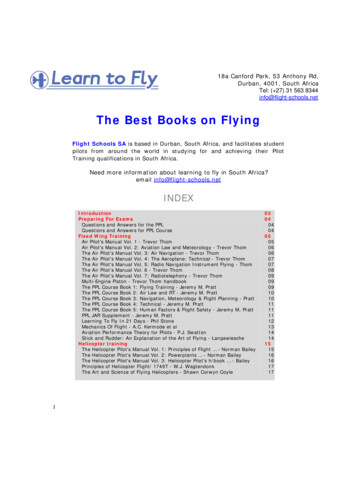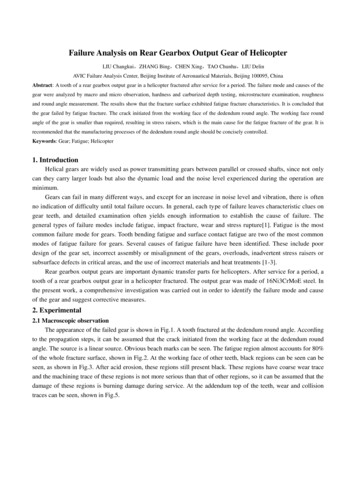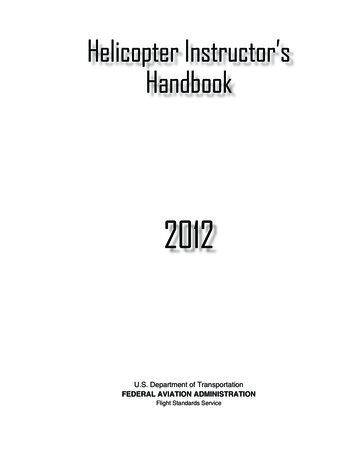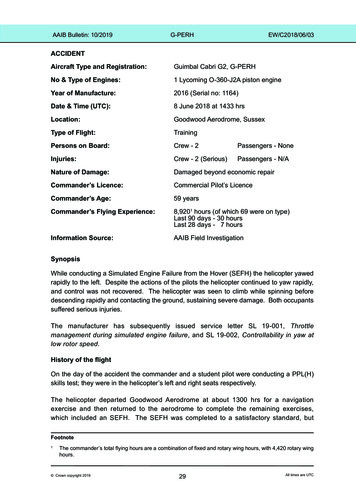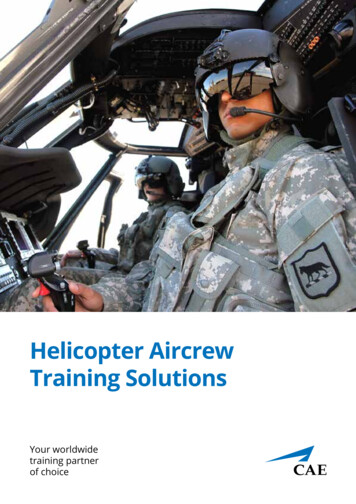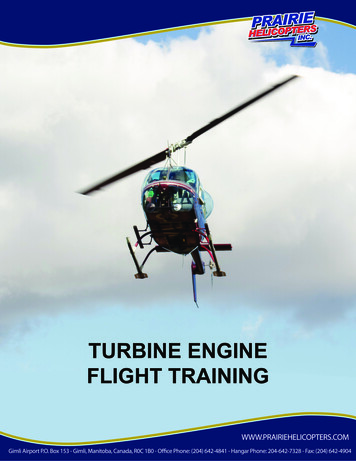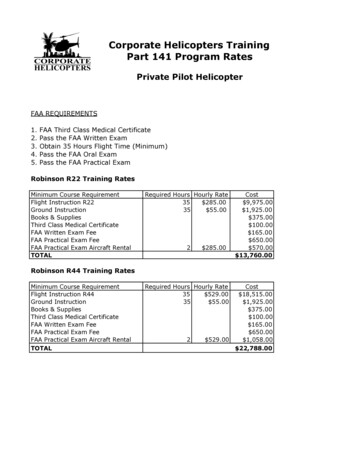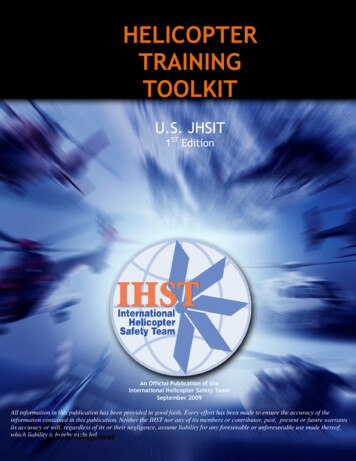
Transcription
HELICOPTERTRAININGTOOLKITU.S. JHSIT1ST EditionAn Official Publication of theInternational Helicopter Safety TeamSeptember 2009All information in this publication has been provided in good faith. Every effort has been made to ensure the accuracy of theinformation contained in this publication. Neither the IHST nor any of its members or contributor, past, present or future warrantsits accuracy or will, regardless of its or their negligence, assume liability for any foreseeable or unforeseeable use made thereof,which liability isAcknowledgementhereby excluded.
ACKNOWLEDGEMENTSWe wish to acknowledge the group of professional helicopter safety experts that make up theInternational Helicopter Safety Team and the Training Industry Working Group that make thistoolkit possible.Terry PalmerFlightSafety International, JHSIT Training Work Group ChairpersonFred BrisboisSikorsky Director of Safety, JHSIT Co-ChairSue BrisboisEducation Resources, LLC, JHSIT Training Work Group MemberMarty RinconAirSure LTD, JHSIT Training Work Group MemberMike SlivaAmerican Eurocopter, JHSIT Training Work Group MemberComments or suggestions on the content of this document are welcome and should be sent to:IHST Secretariatc/o the American Helicopter Society217 N. Washington Street,Alexandria, VA 22314-2538Email rflater@vtol.orgIf providing editorial comments, please note the specific page and/or paragraph pertaining to yoursuggestion and your contact information.IHST Training Toolkit 2009 2
FORWARDThe 2005 International Helicopter Safety Symposium marked the beginning of an internationaleffort by the helicopter industry to reduce the accident rate by at least 80% by 2016. TheInternational Helicopter Safety Team (IHST) was formed to lead efforts toward reaching theobjective.The IHST formed two teams, first the Joint Helicopter Safety Analysis Team (JHSAT) to analyze theaccident history and provide recommendations to reduce the accident rate. The second team, theJoint Helicopter Safety Implementation Team (JHSIT) uses the recommendations to develop costeffective strategies and action plans to reduce accidents.IHST includes associations such as Helicopter Association International (HAI), EuropeanHelicopter Association (EHA), European Helicopter Operators Committee (EHOC), CooperativeDevelopment of Operations, Safety and Continuing Airworthiness Project (COSCAP) of theInternational Civil Aviation Organization (ICAO), Helicopter Association of Australasia, Centrode Investigação e Prevenção de Acidentes (CENIPA) of Brazil, American Helicopter SocietyInternational (AHS), Airborne Law Enforcement Association (ALEA), Air Medial OperatorsAssociation (AMOA), Association of Air Medical Services (AAMS), International Association ofOil and Gas Producers (OGP), Tour Operators Program of Safety (TOPS), military organizations,aircraft and engine manufacturers, the insurance industry, helicopter industry customer base, and linepersonnel.The JHSAT’s initial report provided recommendations directed at specific missions as well as theworldwide helicopter fleet. One of the key JHSAT findings was a need to develop and implement astandard for pilot training focusing on operational specific scenarios, human factors, and the use ofsimulators and flight training devices (FTDs).This document represents a JHSIT implementation tool designed to assist organizations inunderstanding the fundamentals of effective training and serves as a guide in implementing afunctional training department for small to medium size organizations. This document also provides alist of resources for outsourcing effective training for all sizes of operations.Examples, tools and resources are accessible on the IHST website http://www.ihst.org.Refer to the Resource Guide in Appendix 5 of this document for an itemized list of availableresources.IHST Training Toolkit 2009 3
EXECUTIVE SUMMARYBased on the findings of the U.S. Joint Helicopter Safety Analysis Team (USJHSAT) report issuedin 2007, there is a need to improve training programs to reduce accidents. This toolkit addressessome of the issues uncovered in the report and serves as a guide to establishing, developing andmaintaining an effective training program. It also provides guidance in identifying and utilizingtraining aids, training devices, and simulators to improve aircraft and mission specific proficiency.Implementing the Training Toolkit will improve training effectiveness and improve safety by bothpreventing accidents and mitigating the severity of accidents.Chapter 1 outlines the standards for pilot training in various types of operations from the originalhelicopter rating through the various career paths to mission-specific operations.Therecommendations are a result of the 2007 JHSAT reports.Chapter 2 outlines the procedures and requirements for establishing a professional trainingdepartment within an operation. The procedures are appropriate for any type of dedicated trainingdepartment. The process summarizes the organizational structure and the required elements forbuilding, developing and maintaining a training department that goes beyond the recommendationsin FAA Part 135.Chapter 3 discusses the specific courses and an outline of what material should be included in eachcourse. The chapter describes the subject matter and procedures for teaching human factors,technology and aircraft specific courses. There is also discussion on instructing both flying andnon-flying crew, as well as maintenance and dispatch personnel. The method for developingscenario based training is also described.Chapter 4 provides insight into different strategies for conducting training to maximize learning. Itis based on proven techniques used by professional educators. It provides strategies for improvingthe quality of training and techniques for train the trainer programs.IHST Training Toolkit 2009 4
TABLE OF CONTENTSForward .3Executive Summary . 4Introduction .7Chapter 1 Training Topics . . Special Emphasis . In-flight Emergencies . Human Factors . Initial & Recurring Training . Aircraft Performance and Limitations . Inadvertent Instrument Meteorological Conditions . Aircraft Make and Model . Preflight Planning and Preparation . . Specialized Missions . Safety Management Systems . Flight Data Management 8899999910101010Chapter 2 Establishing, Developing and Maintaining Training Programs . Documents and Control Training Records . Conduct Of Training . Quality Control of Training .1110121314Chapter 3 Training Programs . Human Factors, Risk Management and Decision Making . New Technology Applications (GPS, NVG, TAWS, TCAS) . Aircraft Specific: . . Preflight, Performance, Systems, Abnormal And Emergency Procedures . Initial Training . Recurrent training . Checklists . Scenario Based Mission Specific . Location Specific . Environment Specific . Instrument and Inadvertent Instrument Meteorological Conditions . Training The Trainer . Maintenance Training For Helicopters . Non-rated Crewmembers . . Communication Centers . 1515171717171819191919192021212121Chapter 4 Developing Quality Training . 23 Training Perspective . . 23IHST Training Toolkit 2009 5
Improving Instructional Quality .Trainer Competencies .Quality Lesson Design .Lesson Planning . .Lesson Delivery . .Lesson Evaluation Considerations for Learner-Centered Instruction .Characteristics of Adult Learners and Trainer Responsibilities .Train the Trainer .Specific instructional Strategies that Constitute Excellence in Training .Guidelines for Instructional Strategies Train the Trainer Strategies for Active Learning Guidelines for Peer-Teaching .Guidelines for Collaborative / Cooperative Learning Case Studies Simulations .Using New technology to Aid Learning .Train the Trainer Best Practice Strategies to Improve Quality Train the Trainer: Principles of Quality Practice Applied to Adult Training Programs .Appendices1. IHST Sample Lesson Plan .2. IHST Sample training Evaluation Form .3. Risk Assessment Matrix Example . 4. Training Resources and Training Aidso Media, Manuals, Books . o Aircraft Manufacturers .o Simulators Flight Training Devices o Manufacturers and Training Providers .o HOMPS, Avionics .5. Acronyms 414244IHST Training Toolkit 2009 6
INTRODUCTIONThe JHSAT analyzed reported helicopter accidents as recorded in the NTSB’s U.S.A. database.The JHSAT found that contributing factors in many accidents were the lack of standardizedtraining, lack of simulator availability for single engine operations, lack of operational specifictraining scenarios and a lack of human factors training. Due to the deficiency in effectivetraining, including standardization and availability, operators did not adequately provide trainingand training opportunities to their pilots.This toolkit will help small and medium size operators develop an effective training programthat will show a return on investment, and/or cost effectiveness from both financial and safetyperspectives. It will help organizations develop effective training that is designed to fit the size,nature and specific operation of their organization. This toolkit provides easy-to-useguidance and methods that will assist in developing an organized approach to pilot training thatare proven to prevent accidents. Organizations that adopt the processes outlined in this toolkitwill benefit from the increased skill level of the pilots, reduced costs associated with incidents andaccidents, and benefit from improved retention of personnel. The training recommendations in thisdocument are economically viable and operationally appropriate to the individual operatingenvironment and mission.This toolkit is meant to assist in establishing, developing and maintaining a training department,and enhancing an existing training department and/or effectively utilizing third party trainingoptions.IHST Training Toolkit 2009 7
CHAPTER 1TRAINING TOPICSAcademic TopicsThe following are academic subject areas, for which pilots must have a fundamental knowledge andunderstanding of to conduct safe and efficient ground, pre-flight, and flight procedures in thehelicopter. The pilot should be able to list operating limitations, describe the operation and functionfor each of the helicopter’s systems, use the Aircraft Flight Manual (AFM) to obtain necessaryinformation for safe and efficient operation of the helicopter, including charts:1. aircraft operating systems2. performance planning (takeoff, cruise, landing and special missions)3. emergency procedures (including memory required procedures)4. standard operating procedures5. basic instrument procedures6. aircraft regulations specific to helicopter operation7. operating procedures in the national air traffic control system8. weather analysis for safe flight operations9. minimum equipment list use (MEL)10. proper use of helicopter avionics11. special avionics and communication systems installed (supplements)12. risk analysis/avoidance13. principles of crew or single pilot resource management (CRM/SRM)14. Airmanship, judgment & decision making fundamentalsFlight SkillsThe following are flight operations skills that the pilot must master to safely operate the helicopterthroughout all types of missions.1. safe helicopter control in all phases of flight2. application of performance planning into flight operations3. knowledge and use of emergency procedures4. use of standard operating procedures (SOP)5. flying with reference to flight instruments (IFR flight)6. use of MEL to determine if flight may be conducted or continued7. use and testing of helicopter avionics: communications and navigation equipment8. risk analysis in flight9. in flight application of crew or single pilot resource management (CRM/SRM) principles10. in flight application of airmanship, judgment & decision making principlesSpecial EmphasisThe areas of special emphasis during training have been identified as those areas where accidentscan occur if the pilot is not appropriately trained. These areas should be emphasized duringtraining and require proficiency at the initial certificate training and all recurrent and flight reviewtraining. Autorotation LTE -Loss of tail rotor effectiveness Aircraft performance capabilities & limitationsIHST Training Toolkit 2009 8
Helicopter emergencies & emergency procedures as outlined in the aircraft flight manualInadvertent flight into instrument meteorological conditions (IIMC)Make & model transition trainingAeronautical Decision Making (ADM) & risk managementModel-specific power & energy managementQuick stop maneuversLanding practice in unimproved areas, on landing platforms & pinnacle approachesIn-flight EmergenciesExtensive initial & recurrent training includes helicopter emergencies as outlined in the FAARotorcraft Flying Handbook and Emergency Procedures as outlined in the aircraft-specificRotorcraft Flight Manual. Specific areas for emergency training must include: Autorotation Vortex ring state (settling with power) Dynamic rollover Systems and equipment malfunctions LTE – Loss of tail rotor effectivenessInitial & Recurrent TrainingExtensive initial & recurrent training includes recommended procedures and airspeeds foremergency situations as outlined in the aircraft-specific Rotorcraft Flight Manual. The use ofsimulators and ground instruction is highly recommended to improve the effectiveness ofemergency training. The use of risk analysis tools and crew resource management skills arenecessary components in human factors training.Human FactorsTraining programs are expanded to include Aeronautical Decision-Making (ADM) and RiskManagement as outlines in the FAA Rotorcraft Flying Handbook.Aircraft Performance and LimitationsComprehensive training focuses on aircraft performance, capabilities and limitations as per theaircraft specific Rotorcraft Flight Manual. Initial and recurrent training should include the use ofthat information in preflight planning and in-flight decision making.Inadvertent Instrument Meteorological Conditions (IIMC)Comprehensive training on inadvertent flight into instrument meteorological conditions (IIMC) isnecessary for all rotorcraft training. This training includes: Determination of enroute weather Avoidance of inadvertent flight into instrument meteorological conditions Recovery from inadvertent flight into instrument meteorological conditions In-flight weather abort proceduresThe use of simulators and ground instruction is highly recommended to improve instrument flyingskills and proficiency. The training in instrument skills is a necessary component of all levels ofrotorcraft training as these are considered to be perishable skills.Aircraft Make and ModelEach make and model transition training includes extensive training on power and energymanagement, aircraft performance, capabilities and limitations, and emergency procedures specificIHST Training Toolkit 2009 9
to the make and model of the aircraft. Systems and equipment differences training should also beincluded if there are various models available under the same make and model.The use of aircraft-specific simulators and ground instruction on systems and procedures are highlyrecommended to improve the effectiveness of make and model training. The use of current andapporved checklists and familiarization with the aircraft Rotorcraft Flight Manual are necessarycomponents.Preflight PreparationComprehensive training in preflight preparation includes: Flight risk assessment Personal risk assessment Flight planning Weather planning Performance, capabilities, and limitationsPreflight performance training identifies the importance of conducting a thorough preflightinspection, and the use of a preflight inspection checklist.Specialized Mission TrainingMission specific training should focus on familiarization of the standards and procedures associatedwith specific mission segments as well as the use of specialized equipment unique to mission.The use of simulators and ground instruction is highly recommended to improve the effectivenessof mission specific training. The use of mission specific scenarios and the decision making skillsparticular to the type of operation will enhance the training experience by providing lifelikelocations and circumstances unique to each type of mission. Some of the missions that can besimulated include: air medical, law enforcement, offshore, tour and news gathering.Safety Management SystemsComprehensive training in the policies, procedures and safety culture associated with safetymanagement systems is critical to the success of a SMS program. Education and guidance isrequired for all personal within an organization, large or small. Effective SMS programsincorporate an ongoing educational process to insure compliance within the program. For detailson the elements of an SMS program, please refer to the IHST SMS Toolkit at http://ihst.orgIHST Training Toolkit 2009 10
CHAPTER 2ESTABLISHING AND MAINTAINING TRAINING PROGRAMSThis chapter describes the various components of a training manual and organizational structure ofa formal training department. For many medium to large organizations all of the documents andsections below will apply. For small to medium organizations the organizational structure will becondensed and one person may have multiple roles in the training department.A small operator may feel the cost structure for a formal training department is not feasible andmay elect to utilize a training provider. Professional training providers conduct quality training andprovide all the training records and document control required by government agencies andrecommended by the insurance providers.Documents and ControlTo develop a training program for any size flight department, the following documents should bewritten as aircraft specific. These documents can be presented to the regulatory body (local, state,federal) for approval as the flight department’s Approved Training Program. The training lessonplans and scenarios should be written to include the specific type of mission (i.e. EMS, Offshore,Law Enforcement, Corporate, Private etc ). These documents are the base or core curriculum ofthe training program. They establish the content and standards for the entire training program. General Operating Procedure Manual – This control document specifies:- how to deliver the training program- how to change the training program- establishes leadership responsibility for delivery of the training Flight Scenario Handbook- training scenarios (simple tasks leading to more complex special mission tasks)- details training conditions and focuses on individual pilot tasks Classroom Handbook- general “broad based” discussion of the curriculum covering aircraft systems andprocedures- Any regulatory agency can inspect content for compliance Instructor Notes- detailed notes to provide the instructor with information to support class roomdelivery- organizes all tasks and objects (images) in a detailed system- facilitates a system for documenting corrections Pilot Training Guide- pilot task lists with detailed description for the pilot to determine and perform tostandards- includes single pilot resource management procedures throughout each task Instructor Pilot Training Guide- all of the pilot tasks listed in the Pilot Training Guide with instructor pilot tasks foreachIHST Training Toolkit 2009 11
- provides a “single source” training guide for the instructor to utilize containing thepilot tasks as well as the instructor task responsibilities- facilitates a system for evaluating the instructor’s delivery performance enabling aquality assurance check- standardizes training between all instructors enabling multiple instructors to trainthe same pilot throughout training Courseware curriculum – Includes lesson plans for:- all helicopter systems subjects- normal procedures to include preflight- abnormal procedures- emergency procedures- instrument procedures- annual updates and changes to the courseware Manual(s) Amendment & Revision- the amendment procedure shall be stated and properly controlled- issued upon the authority of the Accountable Manager- accountable manager will authorize all amendments & revisions as required- proposed changes shall be forwarded to the Accountable Manager forapproval using an approved document or form for tracking- amendments or revisions will be in the form of replacement pages with achange tracking form in the beginning of the manual(s)- amendments or revisions shall have the date of issue, affectivity and therevision number.- urgent or emergency amendments or revisions for flight safety reasons willbe distributed via email/electronic means Organization and ResponsibilitiesThis can be developed based on the staffing plan and mission of the flight department. Themost important element is to have clearly defined duties and responsibilities for eachindividual in the aviation department and a training policy that is clearly supported by theexecutive leadership of the organization.Training RecordsIt is important to maintain proper records associated with the training program, such as:o Copies of pilot certification of any course prerequisiteso Pilot critiques and assessments of the course prior to, during and after completiono Copies of any previous course completion certificates that are requiredo Details of each pilot’s experience, and qualificationso Copies of each pilot’s certificates and medical documents including any waiverso TSA documentation if required (copies of passport proving citizenship and pictureID) Format for records - Examples of all training records and associated documentation aretypically included in the training program manual(s). Training Records Auditing - The Director of Aviation, or equivalent position, holds theoverall responsibility for the content and accuracy of training records. This audit should beconducted at LEAST annually.IHST Training Toolkit 2009 12
Course Completion Documentation - Course completion certificates will be developed andexamples for each included in the training program Flight Scenario and ClassroomHandbook documents. Monitoring Client Progress - During the course, instructors will continuously assess eachclient to ensure that he/she is receiving maximum benefit from the instruction. Course Completion - Upon completion of the course a recommendation must be recordedthat the training pilot has competed all of the required training and is considered to have metthe standard for the course.Conduct of TrainingIt is important that training be conducted in a standardized fashion with defined procedures for thevarious situations encountered in a training program. The following are processes and proceduresto be established when setting up a training program: Client Discipline – Process for action when a training pilot exhibits an attitude towards thetraining program, department, company not conducive to efficient or safe operation of thetraining department, a report will be forwarded to the accountable manager immediately foraction or review. Poor performance, slow progression or standards not being met – Process for managingpoor performance Sickness or injury – Process for when a training pilot becomes sick or sustains an injury thathe/she is unable to continue training Interruption of training – Process for when training is interrupted and the training pilot hasto return to flying a revision course appropriate to the time delay shall be developed andrecorded in their training records. Duty Time – duty time limitation plan shall be developed and documented in this trainingprogram. Ground School Training - The maximum duty period for ground school training is 9 hoursin any one day. Start times should not begin earlier than 0600 and not extend beyond 1800hours. Flight Training - Initial clients should not report for flight duty more than 90 minutes priorto beginning training/briefings. The flight time should not exceed 6 hours in any 24 hourperiod with a rest period between flights no less than 9 hours beginning upon the end ofscheduled training/debriefing. Instructional Methods - Standardization is required throughout the training program toachieve optimum and consistent results. All briefings and debriefings are to be conducted inaccordance with the standards developed in the training documents.IHST Training Toolkit 2009 13
Written or oral testing - Testing will only be administered when the training syllabusincluded in the training program has been completed and the training pilot has attained thestandards required to successfully complete the test. Flight Test Tolerances - The training pilot shall perform and demonstrate the ability tooperate the helicopter within the standards outlined in the training manuals for eachmaneuver or task. The training pilot shall:o Operate the helicopter within the limits of the AFMo Complete all maneuvers with smoothness and accuracyo Exercise good judgment and airmanshipo Apply aeronautical knowledgeo Maintain control of the helicopter at all times in such a manner that the successfuloutcome of the procedure or maneuver is never in doubtRetesting requirements - Additional training may be required and is recommended after afailed test or check flight Quality Control of TrainingFeedback and continuous evaluation of the training program is essential. Techniques for evaluatingthe quality of the training program are: Establish a Flight Data Monitoring (FDM) Program. The purpose of FDM is to provide aformal method that: Identifies the training policy and maintains flight safety standards Assigns responsibilities within the FDM Identifies systems to ensure that all standards and rules are complied with Identifies and documents corrective actions to be taken to ensure that all deviationsare dealt with Evaluates the training policy and safety standards Enhances safety of aviation department by:o Accurate identification of risks with empirical datao Just culture management of safety issueso Due to the protections afforded by an FAA-approved HFDM/FOQA program, amore open dialogue is possible between Pilots and management based on digitaldata to determine how to improve operations and safety.o Evidence-based decision makingo Enhanced training-scenarioso Risk mitigation possible with empirical dataComplete training in the policies, procedures and just culture associated with the use of flightdata management is part of an effective SMS program. Education and guidance is required forall personal on the technology and use of the data that is gathered from the equipment.Effective FDM programs incorporate an ongoing educational process to insure a just culture.For details on the elements of an FDM program, please refer to the IHST FDM toolkit athttp://ihst.orgIHST Training Toolkit 2009 14
Feedback or critique forms - Upon completion of the course, each training pilot shall beoffered a feedback form for them to complete and the forms are reviewed by the QualityManager and the Director of Operations. Trend analysis shall be performed to determinewhich areas of the training program are not performing to standard and may needimprovement. Audit Quality Assurance - A full quality audit or quality assurance audit should beconducted annually to ensure compliance with the standards outlined in the trainingprogram. Ground School and Flight Training Audits - A quality assurance audit should be conductedfor all ground school and flight instructors at least annually and the results of the audit andthe corrective actions is kept in the training records for each instructor.IHST Training Toolkit 2009 15
CHAPTER 3TRAINING PROGRAMSHuman Factors, Risk Management, and Decision MakingTraining in human factors, risk management and decision making is crucial to providing qualityeffective training. Analysis of accidents has continually shown that these elements were deficient.It is imperative that all training includes these elements in great detail and that the training in thesefactors contains current realistic scenarios to reinforce the concepts. These are considered “softskills” and are often difficult to instruct as well as learn unless effective visual training aids areused. Simulators and flight training devices are the most effective tools for instilling theseprinciples. Role playing, teamwork and communication exercises are a
IHST Training Toolkit 2009 4 EXECUTIVE SUMMARY Based on the findings of the U.S. Joint Helicopter Safety Analysis Team (USJHSAT) report issued in 2007, there is a need to improv
